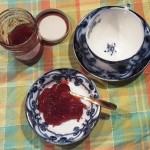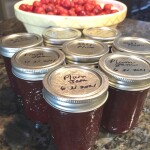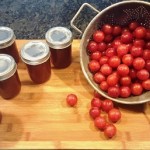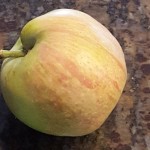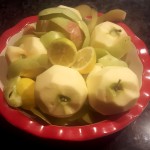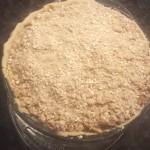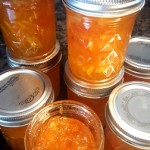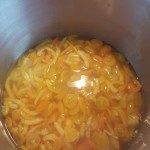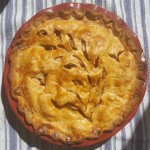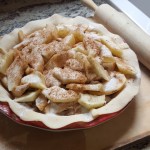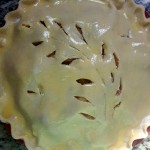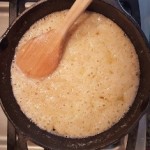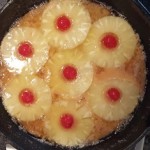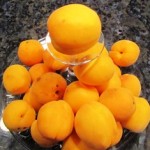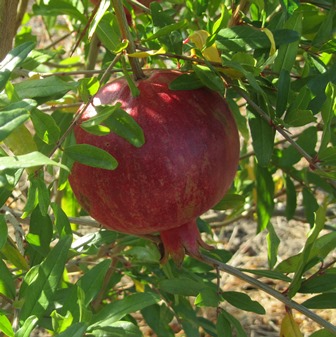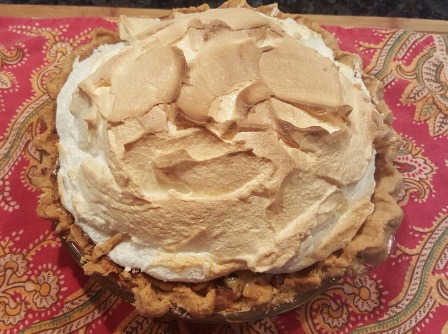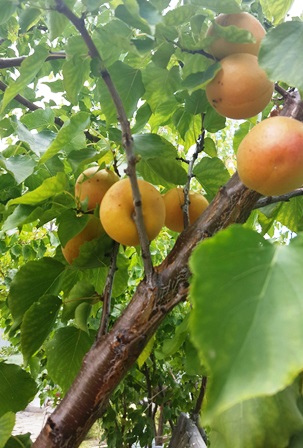Archive for the 'Foods' Category
How to Make Wild Plum Jam
A favorite breakfast on our farmette includes hot bread (like biscuits or popovers), slathered in butter and spread with homemade jam. We have many fruit trees from which to make jam but we love the sweet tartness of wild plums. These wild plums are smaller than regular plums or apricots, so you’ll need to pick enough to fill about a gallon-size bucket.
You’ll love this delicious jam spread on almost any kind of bread, roll, or cracker. Serve it alongside some firm breakfast cheese or your favorite goat cheese. Because of the balance between sweet and tart flavors, it greatly enhances the taste of roast pork or chicken, too.
Making wild plum jam doesn’t require a lot of skill. But you will need some simple kitchen tools like a tall pan (like a soup pot), a large bowl, measuring spoons, a colander, long-handle wooden spoon (for stirring hot jam), and a paring knife.
Required items include a hot-water canner, six or seven preserving jars with lids and rings, and a jar-filling cup, a jar lifter, a foam skimmer, and a magnetized ring lifter. If you don’t already have them, purchased these items in a hardware or diy store where canning jars and utensils are sold.
The PREP steps:
1. Start by picking the fruit and sorting out those plums with blemishes or bird pecked holes.
2. Wash the fruit.
3. Remove the stones. (I use a big bowl for this so I can save the pitted plums along with their juice to make the jam).
The JAM COOKING process.
1. Place 5 cups pitted plums with their juice in a large, deep pot.
2. Squeeze juice of one-half lemon into the pot.
3. Add 4 cups sugar. Stir to mix the ingredients.
4. Bring to a boil and stir constantly for 15 to 20 minutes or until the gel stage is reached. Skim off foam, if necessary.
5. Slowly and carefully stir in five tablespoons of Classic Pectin powder. Mix well. (You can test the gel consistency using a metal spoon chilled in the freezer. The jam should slowly roll to the edge and hang together instead of running off like water.) Remove jam pot from heat.
6. Ladle the hot jam into sterilized jars. Place a lid on each jar and then screw on the rings.
7. Place in the boiling water of a hot-water canner and process for 15 minutes.
8. Remove each jar of jam and listen for the pop of each lid. Let cool in a draft-free area. Label and store.
_____________________________________________________________________
Enjoy reading about country living and farm topics? Check out my cozy mystery novels that include tips and strategies for successful, country living or my nonfiction books on health and spiritual wholeness.
All are available with a search of my name–Meera Lester–on Amazon.com, barnesandnoble.com, and other online and brick-and-mortar bookstores everywhere.
Also, take a look at my wellness and spirituality books for living your best life now. All are available online and wherever books are sold.

More than 150 rituals for sound mind, strong body, and meaningful connections to the people around you
See, https://www.amazon.com/Rituals-Life-Meaning-Everyday-Moments/dp/1507205244
An Apple a Day…or a Slice of Pie
What could be a healthier self-care act than eating an apple? On my way to do chores yesterday, I bumped against the Fuji apple tree, knocking off several. After finishing my chores, I picked up the apples and plucked a few more to take back to the kitchen. Fuji apples (like Cortland, Macintosh, and other firm varieties) are crisp and juicy and hold their shape during baking. Plus, they’re good for you.
Apples are a rich source of dietary fiber and are loaded with antioxidants. They are considered among the healthiest foods because apples decrease the risk for diabetes and thrombotic stroke as well as lower levels of LDL or bad cholesterol.
According to research done at Cornell University, eating an apple a day may help prevent breast cancer. Some compounds in apples are thought to aid in weight loss and lower blood pressure as well.
Inside the house, I ran through my apple recipes. Should I make pie, an apple crisp, crumble, kuchen bars, cake, or some other apple dessert? Pie seemed the simplest. Also, a pie only uses six or eight apples. I could keep the other apples as fresh snacks.
Instead of a regular pie crust, I made a pate brisee in my food processor and chilled the dough for a half-hour before rolling it out into the bottom crust. In lieu of a top layer of pie crust over the apples, I made a crumb topping using oatmeal and brown sugar with a little flour and butter.
The pie turned out delicious. The crumb topping added a little crunch to the softened apple filling and tender, flaky crust. I could have made it even crunchier with the addition of chopped walnuts or pecans.
APPLE PIE with CRUMB TOPPING RECIPE
Ingredients:
8 firm apples, peeled, cored, and thinly sliced
1/2 cup granulated sugar
1 teaspoon cinnamon
Pinch of ground mace
Pinch of freshly grated nutmeg
2 Tablespoons of cold, unsalted butter, cut into small pieces
Directions:
Preheat the oven to 375 degrees Fahrenheit
Position your pastry round over an 8-inch pie plate and press in place. Trim the pastry and crimp the edges.
Toss the apple slices with the spices and sugar and fill the crust. Dot with the butter. Cover the apples with the crumb topping and bake for 45 minutes (cover with aluminum foil during the last five or ten minutes to keep the topping from burning). Remove from the oven and let cool before serving.
CRUMB TOPPING RECIPE
Ingredients:
1/2 cup (1 stick) cold, unsalted butter
3/4 cup dark brown sugar
1/2 cup all-purpose flour
1 cup rolled oats
Directions:
Place butter and flour in the bowl of a food processor and pulse until the mixture becomes like a coarse and crumbly. Add the oatmeal and brown sugar and pulse with the butter/flour mixture until combined. Cover pie with crumb topping.
____________________________________________________________________________________________________
Eating apples is a healthy practice for self care. If you want to learn more about making self-care a priority, check out my latest offering available this fall in time for holiday gift-giving: THE SELF-CARE PLANNER, A Weekly Guide to Prioritize You.

Learn how to schedule personal time to accomplish your dreams and goals for body, mind, and spirit. You’ll find prompts, reminders, and checklists to help you create and stick to your self-care routine. Put this book on your holiday list and find it online where books are sold and in traditional bookstores everywhere. This holiday season, remind yourself that self-care isn’t selfish. It’s an act of love.
Also, if you enjoy reading about country living, growing heirloom vegetables and fruits, and preparing delicious recipes, check out my cozy mystery series that is chocked full of craft ideas, foods, and wellness tips for humans and pets.
All novels are available online and in bookstores everywhere. They include A BEELINE TO MURDER, THE MURDER OF A QUEEN BEE, and A HIVE OF HOMICIDES (Kensington Publishing, NY).
How to Make Kumquat Marmalade
Eating a fresh kumquat–the small relative to the sweet orange–is like getting a dose of Vitamin C in a single bite. Or, if you don’t like the tart fruit (the edible rind is sweet), then make your kumquats into a marmalade.
My neighbor recently brought over several boxes of freshly-picked kumquats. We ate some fresh but I turned the rest into a sweet, spread that tastes quite like orange marmalade.
When fruit is available during the year, you can turn that fruit into a delicious conserve, jelly jam, marmalade, or fruit butter. When citrus is in season, oranges, kumquats, grapefruits, and lemons can be coverted to sweet spreads.
There are distinct differences between conserve, jam, jelly, marmalade, and fruit butter. Conserve is a jam made from fruit with other ingredients added, including raisins, coconut, and nuts. Jelly is made from the juice of the fruit while jam is made from the fruit pulp. Marmalade includes fruit, juice, and rind. A fruit butter utilizes the fruit pulp and sugar to make a thick, smooth spread.
KUMQUAT MARMALADE RECIPE
Ingredients:
2 cups thinly sliced kumquats
1.5 cups chopped orange pulp (2 medium oranges)
1.5 cups sliced orange peel (2 medium oranges)
1/3 cup lemon juice
1.5 quarts water
Sugar (the amount will depend on the amount of fruit/water mixture after 12 hours)
Directions:
Mix together all ingredients, except the sugar, in a deep large pot. Simmer for 5 minutes. Remove from heat and cover. In a cool place, allow the mixture to stand for 12 hours or overnight to soften the rind. Remove any large seeds. Cook rapidly until peel has softened. Measure out fruit and liquid mixture and then add 1 cup of sugar for each cup of the fruit mixture. Stir until the sugar is dissolved.
Rapidly bring the mixture to a boil over high heat. Stir as needed to prevent sticking, especially as the mixture thickens and reaches the gelling point. (Hint: You can check to see if the marmalade is gelling by dropping a spoonful of the hot marmalade onto a chilled or frozen saucer. If the marmalade is sheeting instead of running off the plate, it’s ready to can. Also, you can add Classic Pectin according to directions on container to ensure the marmalade properly thickens). Stir in carefully to avoid splattering on your skin. Remove from heat. If the mixture has foam, skim to remove it. And also remove any large seeds that may have been missed.
Ladle the hot fruit mixture into hot jars (run the jars through a hot rinse cycle as the jam is cooking). Leave 1/4-inch headspace. Tighten the ring around the flat, rubber-seal cap. Place the jars into a boiling-water canner. Bring to a boil and process 10 minutes. Remove jars from canner and let stand until cool. The caps will make a popping sound as they cool and seal.
__________________________________________________________________

- All of Meera Lester’s Henny Penny Farmette mysteries are available online and in bookstores everywhere. Also, check out Meera Lester’s self-help books on health, wellness, and spirituality on Amazon.com See: https://www.amazon.com/Meera-Lester/e/B001JP835E
Pie to Welcome Autumn, Plus a Few Apple Facts
Autumn officially arrives next Friday, September 22, 2017. That means peak apple season has begun and nothing says “fall” like an early-autumn apple pie.
Here’s my easiest apple pie recipe.
COUNTRY APPLE PIE
Ingredients:
6 cups apples, peeled, cored, and thinly sliced
3/4 cup granulated sugar
2 tablespoons butter
1/8 teaspoon salt
1 teaspoon cinnamon
1/2 teaspoon ground nutmeg
2 tablespoons flour
2 unbaked pie crusts (homemade or store-bought)
1 egg, beaten with 2 tablespoons water (to make an egg wash)
Directions:
Preheat oven to 450 degrees Fahrenheit
Combine sugar, flour, salt, cinnamon, and nutmegr in a large bowl and mix well. Stir in the apples. Spoon the apples into a pastry-lined baking dish or pan. Cut the butter into small pieces and distribute over the apples. Place the second rolled-out crust over the pie. Snip off the excess crust and cut a design into the top crust to create a steam vent. Flute crust edges. Use a pastry brush to apply the egg wash over the top crust.
Bake for 10 minutes. Cover crust edges with aluminum foil to keep them from burning. Reduce heat to 350 degrees and bake for 30 to 35 minutes. Crust will be golden brown and juices will be bubbling.
FACTS ABOUT APPLES
1. Apples were known in the ancient world; they’ve been around for 3,000 years.
2. Apples thrive in a temperate climate and are grown worldwide.
3. There are roughly 7,000 varieties of apples worldwide, all members of the rosaceae family.
4. Washington state produces half of all U.S. apples.
5. Science shows that apples are rich in antioxidants and vitamins A and C, are high in fiber, and and aid in lowering cholesterol and high blood pressure. They can help stabilize blood sugar levels.
6. Some of the best-loved apple varieties include: Braeburn, Red Delicious, Granny Smith, Gala, Fuji, Golden Delicious, Honeycrisp, and Rome.
If you want to know which apples are best for baking, eating fresh, making into sauces, or freezing, see, http://bestapples.com/varieties-information/varieties/
_____________________________________________________________
If you enjoy reading about delicious farm recipes, growing heirloom plants, or keeping bees and chickens and you like a mysteries, check out my Henny Penny Farmette series of cozy mysteries from Kensington Publishing in NY. They’re available online and in traditional bookstores everywhere.

Murders at a N. California winery are the catalyst for ex-cop turned farmette owner Abigail Mackenzie to search for a killer
Currently, A HIVE OF HOMICIDES is a featured title in Barnes & Noble’s September promotional BUY 3, GET 1 FREE sale.
WHAT IS THE BUY 3, GET 1 FREE OFFER?
Everyone who buys a Kensington cozy mystery from the B&N in-store display or any Kensington cozy mystery from BarnesandNoble.com between 9/5/17 – 10/5/17 and registers their purchase at http://sites.kensingtonbooks.com/kensingtoncozies/BN/ will:
— Automatically be entered into Kensington’s “Cozy Mystery Bonanza” sweepstakes for a chance to win a $300 value gift basket. One grand prize winner will be selected after the sale has concluded.
— Automatically receive a free Kensington Cozies recipe booklet plus a download code for the novel A STORY TO KILL by Lynn Cahoon after the sale has concluded.
* * *
DON’T FORGET TO ENTER THE FREE DRAWING AT GOODREADS.COM.
Win a signed copy of A Hive of Homicides along with a gorgeous reversible apron and a set of 2 chicken napkin rings. Enter before September 26 for a chance to win.
See, https://www.goodreads.com/book/show/33911114-a-hive-of-homicides?from_search=true
Celebrating the Fourth–Hankering For Nostalgia
On the farm where I grew up in central Missouri, we celebrated the Fourth of July with a fish fry. We caught blue gill, bass, crappie, and catfish in my grandfather’s stocked ponds or from nearby Perche Creek.
After my brother, cousins, and I played games until dark and then chased fireflies, my grandmother would set out dessert–a simple blackberry pie, shortcake and berries with homemade ice cream, or a pineapple upside down cake. A grownup would surprise us kids with sparklers that we would light and wave as we ran around in the dark.
Feeling nostalgic for those old days and ways of celebrating, I’m going to shuck and cook corn on the cob and grill some salmon with fresh veggies from the garden for this–our eighth celebration of this holiday on the farmette. There’s a ton of summer squash that I’ll douse with olive oil and sprinkle with seasoning before grilling.
For the salmon, I make a easy-peasy mango-lime-cilantro salsa. Chop red onion and red and green bell pepper. Cube slices of fresh mango. Take a handful of cilantro that’s been tightly rolled and chop it into ribbons. Mix everything together, sprinkle with sugar, and generously drizzled with fresh lime juice. Serve well chilled over the grilled salmon.
I’ve already whipped up a pineapple upside down cake and baked it in my 10-inch cast iron skillet. To save time, I used a yellow cake mix and added a dash of rum and pineapple juice for flavor. Recipe is below.
QUICK PINEAPPLE UPSIDE DOWN CAKE
Ingredients:
1/2 cup plus 2 Tablespoons butter
1 1/4 cups sugar
7-8 slices of canned pineapple
7-8 maraschino cherries
1 box yellow cake mix
1 Tablespoon dark rum
1/8 cup pineapple juice
Directions:
Preheat oven to 350 degrees Fahrenheit
In a cast iron skillet over medium heat, melt the butter. Add the sugar and stir until the sugar turns light brown (roughly 5 to 7 minutes). Remove from heat. Carefully lay in the pineapple slices. Place a cherry in the center of each fruit ring.
Make the cake according to directions on the box. Add the rum to the batter. Pour over the pineapple slices in the skillet.
Place the skillet on the middle rack in the oven and bake the cake at 350 for 30-40 minutes. Guard against over browning of the top. If necessary, lay a layer of aluminum foil over the cake near the end of the bake time. Use a knife around the cake edges to loosen from the skillet. Turn upside down onto a cake plate. Enjoy.
_______________________________________________________________
If you’re interested in farmette topics and storytelling, check out my Henny Penny Farmette series of mysteries. All three books in the series are available in numerous formats and can be ordered from Amazon, Barnes and Noble, and elsewhere online as well as from traditional bookstores everywhere.
These cozy mysteries make great summer reading and they include delicious recipes, tips for keeping bees and chickens, and facts and tidbits about growing heirloom vegetables and herbs.
Please see more at http://tinyurl.com/ya5vhhpm
Busy Bees and Abundant Rain Spell Bumper Crops in the Orchard
Thanks to the drought-ending rain and the robust activity of our honeybees, my orchard has produced a phenomenal crop of cherries, apricots, and plums this year.
I picked some wild plums today. They’re unusually sweet so I will make them into jam this week. I think the apricots will be ready next week. Today, I’m getting ready for jam-making by taking down cases of canning jars from the storage shelf over the washer and dryer. I’ll need to get lemons, bags of sugar, pectin, and jar lids.
The vegetable garden is also benefiting from bee activity. The summer Italian striped squash and the crooked neck squash plants are producing squash faster than we can eat them. The tomato vines are loaded, and I expect the corn to be ready soon, too.
Nothing beats fresh summer jams to brighten a dreary winter morning. This summer, I hope to make enough to last through 2017 winter into next spring. This past winter, I ran out of apricot jam because it is the one most of our neighbors, family, and friends prefer. But thanks to the rain and the bee activity, running out of jam won’t be a problem for next year.
____________________________________________________
Like my honeybees, I’ve been busy this winter/spring, writing two nonfiction books for readers who embrace the path of yoga, healthy living, meditation, meaningful ritual, and mindfulness. To be released this year: My POCKET MEDITATIONS (July 2017) and MY DAILY RITUALS (Christmas 2017).
Check out MY POCKET MEDITATIONS, the newest forthcoming nonfiction title from Adams Media/Simon & Schuster, at http://tinyurl.com/l6lzorq
![My Pocket Meditations: Anytime Exercises for Peace, Clarity, and Focus by [Lester, Meera]](https://images-na.ssl-images-amazon.com/images/I/51GH%2BXEPc6L.jpg)
COMING SOON: My newest offering in the Henny Penny Farmette mystery series, A HIVE OF HOMICIDES (Kensington Publishing, Sept. 2017).
Pomegranate Seeds–A Sweet Explosion on the Tongue
Strolling through our small orchard today, I cut into a pomegranate to check on the seeds–the edible part of the fruit. To my surprise, they had turned ripe. Inside, the seeds were gorgeous red jewels, plump and juicy. The sweet juice in the seeds carries a powerful antioxidant punch, too; it’s loaded with Vitamin C, Vitamin K, fiber, potassium, protein, and folate.
You might wonder about ways of cooking with pomegranate seeds. How about tossing them into citrus or a green salad, pairing them with goat cheese on a crostini, or sprinkling a few on poached pears dipped in chocolate, or incorporate them into a Mediterranean couscous with cashews or pistachios?
I think I’ll make some pomegranate jelly–it tastes great on toast, makes an excellent foil for goat cheese, and also creates a moist and delicious glaze for chicken.
The hardest part of making the jelly is separating the seeds from the white pith that holds the seeds in place inside the leathery peel.
The jelly recipe consists of few ingredients: pomegranate juice, sugar, water, and classic pectin. Here’s how I make the jelly.
POMEGRANATE JELLY RECIPE
Ingredients:
3 1/2 cups pomegranate juice (well strained to remove all the particles)
5 cups granulated sugar
6 tablespoons classic pectin
Directions:
Prepare boiling water canner and wash eight to ten half-pint jars in the dishwasher.
Place rings and lids in a pan of simmering hot water.
Cut one end of the pomegranate off to expose the membranes and seeds.
Section the pomegranate and scrape the seeds out into a medium to large bowl.
Repeat the process until you had several cups of seeds.
Rinse well and then run the seeds through a juice extractor.
Strain out the juice through a jelly bag or multiple layers of cheesecloth. Note: The juice stains, so take care to protect kitchen counters and clothing.
Put the juice and pectin into a large pot and bring to a boil, carefully stirring to blend in the pectin.
Add sugar and stir until completely dissolved and boil for one minute at a roiling boil that cannot be stirred down. Ladle off foam, if necessary.
Ladle jam into clean, hot jars leaving one-quarter inch head space. Attach hot lids and then the rings. Tighten to finger tight.
Lower the filled and sealed jars into the canner. Process for 10 minutes at a roiling boil. Remove and let cool.
* * *
If you enjoy reading about farmette topics (including gardening, beekeeping, and delicious recipes), check out my cozy mysteries A BEELINE TO MURDER and also THE MURDER OF A QUEEN BEE in the Henny Penny Farmette series (from Kensington Publishing).
These novels are available through online retailers such as Amazon, Barnes & Noble, Kobo Books, and Walmart as well as from traditional bookstores everywhere.
See, http://tinyurl.com/hxy3s8q
Now available in mass market paperback, this debut novel launched the Henny Penny Farmette series of mysteries and sold out its first press run.
See, http://tinyurl.com/h4kou4g
The second cozy mystery in the Henny Penny Farmette series, available Sept. 27, 2016, is now available on Net Galley (netgalley.com) for professionals and readers who write reviews. The book may be pre-ordered as well. Click on the link under the image.
Great Pie Begins with a Buttery, Flaky Crust
My stalwart Scots-Irish grandmother was thrifty and talented when it came to food preparation. She made delicious pies from cherry, rhubarb, peaches, apples, pears, and sweet berries of every kind, including gooseberries. Her pies were my childhood delight when I lived with her and my grandfather on their Boone County, Missouri farm.
She made delicious meat pies from meats she’d preserved by canning. Missouri winters could be harsh. Those meat pies nourished me when the snow piled up outside the windows, and it was too cold to make a trek to the smoke house where her prized Boone County hams hung from hooks.
Sometimes, my grandmother combined fruits or berries in a rustic pie (today, we call it a galette) and on other occasions, she made a raisin, pecan, pumpkin, coconut, or a custard pie. And meringue, if used, was high and sweet and just the right shade of golden brown. But it was the pie crust that I loved.
For the top of a peach pie, she’d cut in a large curve shaped like a branch. Then two or three other lines would curve from it. Lastly, she cut teardrop shapes along the arch lines so the top crust art would suggest a peach tree branch. When she worked crisscross strips atop a cherry pie, it was both beautiful and delicious.

Storing or rolling the crust between sheets of plastic wraps is a good way to avoid handling the crust with your hands.
The secret to her buttery, flaky crust was not to handle it too much. Today, I make the same recipe but in my food processor. Like her, I use chilled or ice water, adding only drops at at time as the food processor is pulsing the dough–only enough to get the dough clinging together. The point is to move the dough from dry and crumbly to clumping into a ball.
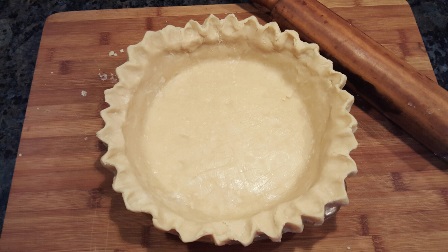
This fluted crust is ready for almost any kind of filling. I will prick the bottom and sides with a fork before filling and baking.
After the dough is made, I dump it from the food processor bowl onto aluminum foil or plastic wrap and work it into a ball (without touching it). The dough goes into the fridge for a chill over an hour and up to 24 hours. The recipe makes enough for a pie top and bottom or a couple of pies requiring only the bottom crust.
Ingredients:
2 1/2 cups flour
1/2 teaspoon salt
1 teaspoon granulated sugar
1 cup chilled unsalted butter, cut into pieces
1/4 (plus a few tablespoons more if necessary) cold or ice water
Directions:
Add the dry ingredients (flour, salt, and sugar) in the food processor bowl.
Cut the butter into small chunks and drop the pieces in. Pulse into a crumbly, dry meal.
Add ice water to the mixture in the bowl by dropping spoonfuls through the feeding tube and pulsing after each addition.
Remove the dough when it clings together–neither too wet nor too dry–by dumping it out on a large sheet of aluminum foil or plastic wrap.
Mold the dough into a ball and flatten into a thick disk to make it easier to roll out.
Chill for an hour or up to 24 hours.
Makes two buttery, flaky crusts.
* * *
If you enjoy reading about farmette topics (including gardening, beekeeping, and delicious recipes), check out my cozy mysteries A BEELINE TO MURDER and also THE MURDER OF A QUEEN BEE in the Henny Penny Farmette series (from Kensington Publishing).
These novels are available through online retailers such as Amazon, Barnes & Noble, Kobo Books, and Walmart as well as from traditional bookstores everywhere.
See, http://tinyurl.com/hxy3s8q
Now available in mass market paperback, this debut novel launched the Henny Penny Farmette series of mysteries and sold out its first press run.
See, http://tinyurl.com/h4kou4g
The second cozy mystery in the Henny Penny Farmette series, available Sept. 27, 2016, is now available on Net Galley (netgalley.com) for professionals and readers who write reviews.
Summer Salad with a Mediterranean Flair
Inspired by a salad made of lentilles du Puy that I recently ate at a Mediterranean restaurant, I decided to create my own version of it.
The salad combines tiny greenish/brown French lentils with seasonal fresh produce such as heirloom tomatoes and zucchini . I added a chopped onion (sauteed) and some hard-boiled eggs. Dried mint, crumbled fine, along with a little salt and pepper is the only seasoning you’ll need.
This salad is delicious served warm. But it is equally tasty served chilled on very hot days.
French Lentil, Zucchini, and Tomato Salad
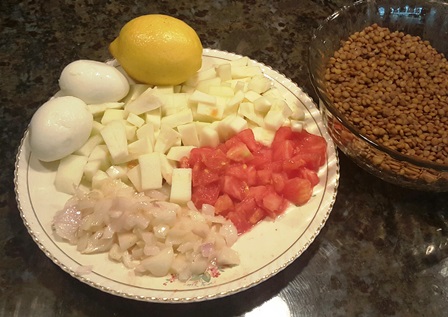
Ingredients for lentil salad include sauteed onions, heirloom tomato, zucchini, hard-boiled eggs, and fresh lemon juice
INGREDIENTS:
1 cup cooked French lentils (the small green or brown variety)
1/2 cup cooked Basmati rice
1 small firm tomato, skinned and chopped
1 cup peeled and chopped fresh zucchini
1 medium red or yellow onion, coarsely chopped and lightly sauteed
2 hard-boiled egg, chopped
1/4 c dried mint, crumbled fine by rubbing between your palms
1/2 medium juicy lemon
salt to taste
DIRECTIONS:
Combine the cooked lentils and rice. Add the zucchini, tomato, sauteed onion, and chopped hard-boiled egg to the lentil-rice mixture. Crumble the dried mint over the salad. Season with salt and pepper. Squeeze the juice from 1/2 lemon over the mixture and combine well before serving. Serves 4-6.
*Try pairing this salad with a rosemary chicken or lamb wrap for a light lunch.
* * *
If you enjoy reading about farmette topics (including gardening, beekeeping, and delicious recipes), check out my cozy mysteries A BEELINE TO MURDER and also THE MURDER OF A QUEEN BEE in the Henny Penny Farmette series (from Kensington Publishing).
These novels are available through online retailers such as Amazon, Barnes & Noble, Kobo Books, and Walmart as well as from traditional bookstores everywhere.
Now available in mass market paperback, this debut novel launched the Henny Penny Farmette series of mysteries and sold out its first press run.
The second cozy mystery in the Henny Penny Farmette series, available Sept. 29, 2016
California’s Farmers’ Markets Are in Full Swing
Nothing beats eating farm-to-table fresh vegetables, fruits, and berries. But what if you don’t have time or the room to grow wholesome, healthy foods yourself?
Our California farmers’ markets offer a dazzling variety of fruits, vegetables, berries, and nuts. These items are trucked or otherwise brought into our communities from local area farms and orchards.
Many fruits and vegetables are certified organic. That means the farmers and growers are registered and in compliance with state and local regulations designed to protect consumers and ensure food quality and safety.
Annually, California produces nearly half of the nation’s fruits, nuts, and vegetables, according to the California Department of Food and Agriculture. See http://www.cdfa.ca.gov/Statistics/
The San Joaquin Valley of central California has earned the moniker of the World’s Food Basket since its crops account for 12.8 percent of all agricultural products from California. https://www.cdfa.ca.gov/Statistics/PDFs/2015Report.pdf
California produces 88% of the nation’s strawberries
In fact, California leads the nation in production of figs, dates, plums, melons, nectarines, peaches (Clingstone and Freestone), pears (Bartlett), persimmons, raspberries, and apricots.
California apricots are available May through July
In the Golden State, you can find dozens of types of fruits offered at 350 farmers’ markets (some open all year long).
From the Pacific Coast Farmer’s Market Association, the following list (recapped below) reveals when these fruits are in season in California.
Apples: January-February; August-December
Apricots: May-July
Blackberries: June-September
Blueberries: May-August
Boysenberries: June-August
Cantaloupe: May-September
Cherries: April-June
Citrus: January-March; November-December
Dates: September-December
Figs: September-November
Grapes: August-November
Kiwi: January-April; October-December
Melons: June-September
Nectarines:May-September
Peaches: May-September
Pears: September-December
Persimmons: September-November
Plums: May-October
Pluots: May-September
Pomegranates: September-November
Prunes: May-September
Raspberries: May-October
Strawberries: February-November
Watermelon: July-September
* * *
If you enjoy reading about farmette topics (including gardening, beekeeping, and delicious recipes), check out my cozy mysteries A BEELINE TO MURDER and also THE MURDER OF A QUEEN BEE in the Henny Penny Farmette series (from Kensington Publishing).
Both area available through online retailers such as Amazon, Barnes & Noble, and Walmart as well as from traditional bookstores everywhere.

Now available in mass market paperback, this novel launched the Henny Penny Farmette series of mysteries
 Facebook
Facebook Goodreads
Goodreads LinkedIn
LinkedIn Meera Lester
Meera Lester Twitter
Twitter





